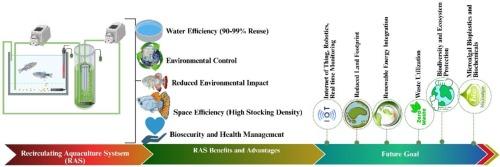Recirculating aquaculture systems: Advances, impacts, and integrated pathways for sustainable growth
Q1 Environmental Science
引用次数: 0
Abstract
Recirculating aquaculture systems (RAS) offer a transformative approach to sustainable fish and shrimp farming by minimizing water use, enabling high-density production, and providing precise environmental control. Between 2020 and 2025, innovations such as low-head oxygenation, modular biofilters, integrated microalgae units, AI-driven feeding, and cold atmospheric plasma disinfection improved efficiency, biosecurity, and sustainability. This review synthesizes advances in engineering design, water quality management, automation, species-specific welfare optimization, and economic performance. Integrating microalgae and microbial consortia enhances nutrient recycling, CO₂ sequestration, oxygen production, and biofilter resilience, advancing zero-waste objectives. Concurrently, optimized flow regimes, lighting, and feeding protocols improve growth performance and welfare across species. Despite progress, challenges in energy intensity, microbial stability, system complexity, and cost scalability remain. Future directions include renewable energy integration, standardized protocols, interdisciplinary training, and supportive policies to accelerate adoption of circular, precision aquaculture. This review provides a critical resource in designing resilient, next-generation RAS.

循环水养殖系统:可持续增长的进展、影响和综合途径
循环水养殖系统(RAS)通过最大限度地减少用水、实现高密度生产和提供精确的环境控制,为可持续的鱼虾养殖提供了一种变革性方法。2020年至2025年期间,低水头氧化、模块化生物过滤器、集成微藻装置、人工智能驱动饲养和冷大气等离子体消毒等创新提高了效率、生物安全性和可持续性。本文综述了工程设计、水质管理、自动化、物种特异性福利优化和经济效益等方面的研究进展。整合微藻和微生物群落可提高养分循环、CO 2固存、氧气生产和生物过滤器弹性,推进零废物目标。同时,优化的流动制度、照明和喂养方案提高了物种的生长性能和福利。尽管取得了进展,但能源强度、微生物稳定性、系统复杂性和成本可扩展性方面的挑战仍然存在。未来的发展方向包括可再生能源整合、标准化协议、跨学科培训和支持政策,以加速采用循环、精准水产养殖。这一综述为设计具有弹性的下一代RAS提供了关键资源。
本文章由计算机程序翻译,如有差异,请以英文原文为准。
求助全文
约1分钟内获得全文
求助全文
来源期刊

Bioresource Technology Reports
Environmental Science-Environmental Engineering
CiteScore
7.20
自引率
0.00%
发文量
390
审稿时长
28 days
 求助内容:
求助内容: 应助结果提醒方式:
应助结果提醒方式:


